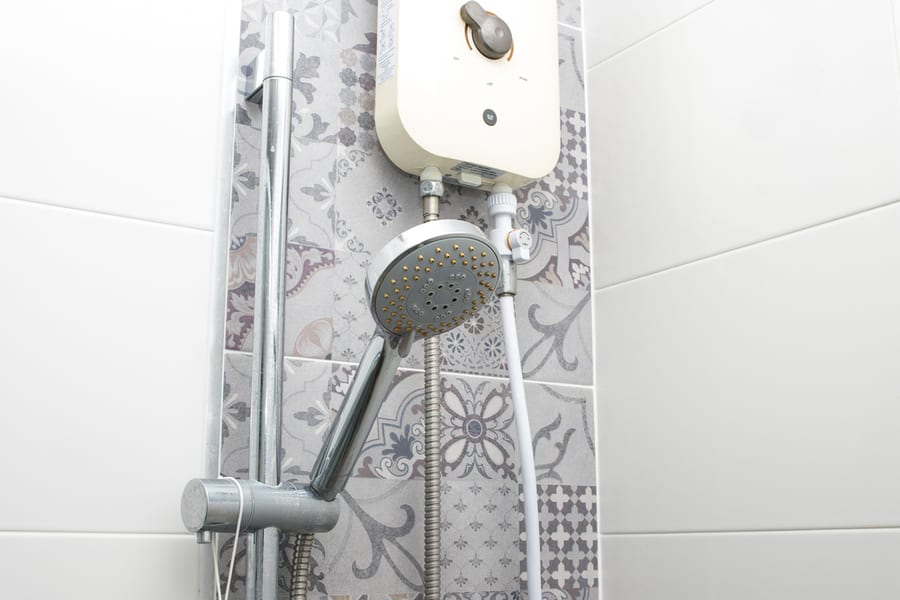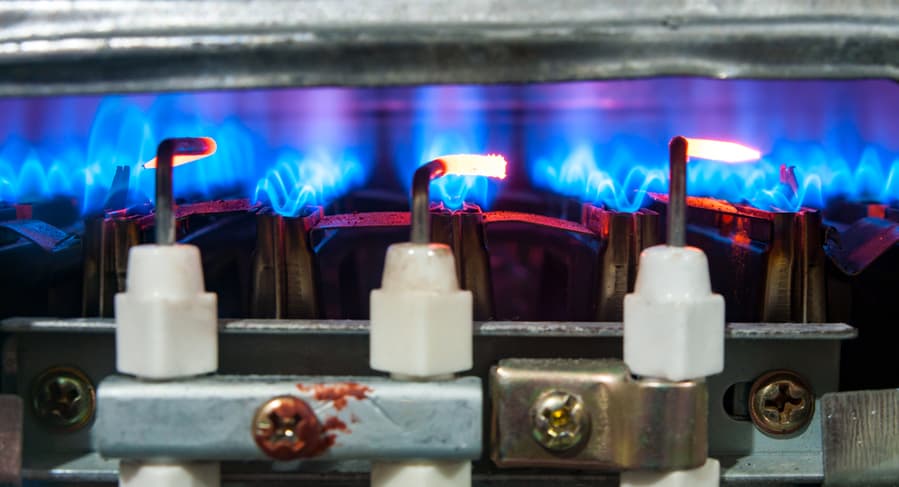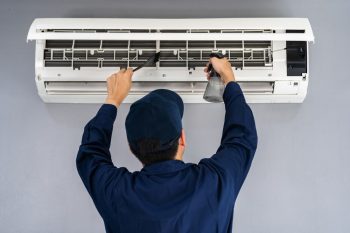
Tankless water heaters have been advertised as a way to never run out of hot water. When they work, they are amazing.
However, sometimes they don’t. If your tankless water heater gives you an e5 error code, it could be for many reasons.
An e5 error code is usually related to pressure. In the process, the unit detects either too high or too low pressure.
Possible reasons include the following:
- Excessive water pressure.
- A poorly ventilated room.
- A clogged or broken exhaust fan.
- A dirty air filter.
- Air in the gas line (for gas models).
Keep reading for ways to deal with these issues, how to clear the error code, and when to call a professional.
3 Causes of an e5 Error Code
An e5 error code can mean different things between manufacturers, but it usually has to do with an incorrect pressure detected by the unit. This can include water pressure, air pressure, and gas pressure.
1. Air Pressure

Checking the air pressure in the unit is where I recommend most people start troubleshooting. These issues are the easiest to notice and therefore rule out.
Poorly Ventilated Room
Your water heater spits out hot air as it does its thing. This can increase the ambient air pressure and temperature in a poorly ventilated space. The water heater has a sensor to detect this issue and will throw an error code when it is detected.
Testing
To test for this issue, open the door and window in the room containing your water heater. Let the room air for ten minutes, clear the error code, and then use the water heater while the door opens.
If the error code does not return, then you’ve found your problem.
Solution
If your water heater is having problems with ventilation, it may be because the space is too enclosed (such as a closet). Consider replacing the door with one with slats or holes, as this will allow the air to circulate.
Clogged Exhaust
Another common problem that results in excess air pressure is a clogged exhaust vent. The exhaust vent can become clogged by dust, dirt, and hair over time. It can also become a warm nest for some animals (like mice).
Testing
Inspect the exhaust while the unit is off for any clogging.
Solution
If you find clogging in the exhaust, you can clean it out with a shop vac and rag.
Broken Exhaust Fan
Even if the exhaust is free of obstructions, it cannot work properly with a broken fan. In addition, fans wear out over time, which is especially likely for an older model.
Testing
After resetting the unit to clear the error code, please turn it on. Observe the exhaust to see if it is putting out air and whether the fan is turning.
Solution
The fan must be replaced, which often requires a professional’s assistance.
When a water heater works properly, the metal around the exhaust can be hot enough to burn. Therefore, when testing the function of the exhaust vent, avoid touching anything.
Dirty Air Filter
The component that can cause improper air pressure is the air filter. This looks like a fabric box about one inch thick, often set inside a vent. If the filter becomes too dirty, the air cannot flow through it, which causes the unit to throw an error.
Testing
Locate the air filter, and remove it from its housing. If you have trouble finding it, consult the manual for your model.
After you’ve removed it, inspect it. Most air filters should be very light, almost white, in color. This is to make it apparent when it is dirty. It is dirty if you feel a buildup on the filter or notice it is very dark.
Solution
If the air filter is dirty, you must clean or replace it. In either case, cleaning the housing, the air filter sits in with a damp cloth is a good idea.
To clean an air filter, rinse it off with lightly pressurized water. Doing this outside with the garden hose is best.
Then, once it becomes light in color, set it out to dry. This will take 1 to 2 days (never put a wet air filter into your water heater).
If it is too dirty to clean or isn’t designed to be cleaned, you will need to buy a replacement, and install it.
2. Gas Pressure

If your unit is gas-powered, an e5 error code can also refer to the gas line. If the gas line is the reason for the e5 error code, it is usually because of air in the line. This is a little tricky to fix, and I would call a professional.
You’ll need to flush the system if you’re set on doing it yourself.
- First, remove the power to your water heater.
- Turn on the hot water for your kitchen and sink faucets.
- Locate the valve on the gas line.
- Open it up.
- Find the pressure release valve on the water heater.
- Open the pressure release valve until you hear hissing.
- Let them vent for a few seconds, then close the gas valve.
- Keep the pressure valve open until pure water comes out, then close it.
- Close the faucets once they are also steady water.
3. Water Pressure

The last common reason for an e5 code is that the water pressure is too high for your water heater to keep up. You can fix this by only opening the water supply valve halfway or replacing your water heater with a more powerful unit.
Once you’ve done this, the error code shouldn’t return.
How To Clear an Error Code in Your Water Heater

You should be able to find specific advice for your model in the manual, but you can generally clear an error code by resetting the unit.
To reset your unit, turn off the power to the water heater from the breaker box. Wait 10 to 15 minutes before restoring the power. If the code has been successfully cleared, it should no longer appear on display.
Summary
An e5 error code in a tankless water heater most often refers to the pressure in the system. This most often results from dirty air filters or exhaust ducts. It could also mean that your exhaust fan isn’t working.
If none of these is the issue, check to ensure no air in your lines and reduce the water pressure in the intake pipe.
Frequently Asked Questions
How Often Should I Clean the Air Filter In My Water Heater?
The air filter should be cleaned or replaced every 6-8 months. Ignoring the air filter in your water heater leads to a decrease in efficiency and, eventually, an error code. In extreme cases, the air filter may even cause a fire.
How Do I Know That My Water Heater Is in a Well-Ventilated Space?
The room that your water heater is in should be well-ventilated. Signs of a poorly ventilated room include:
- Frequent e5 error codes that resolve after airing.
- Difficulty opening or shutting the door.
- A very noticeable temperature difference between the water heater’s room and the area just outside the door.












